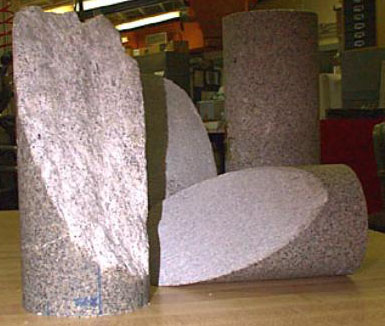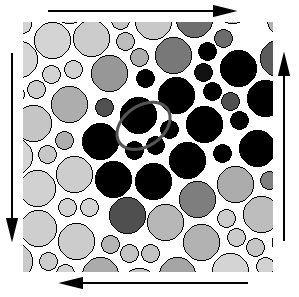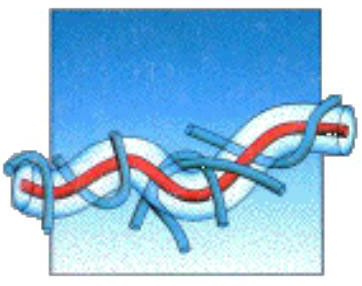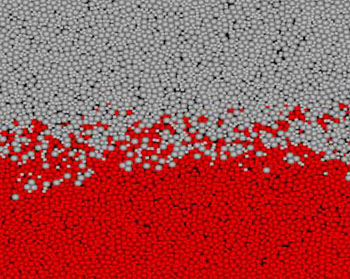Rate and State Laws
 Over the last decade
there has been a growing appreciation of the importance of incorporating
history dependence in the description of materials far from equilibrium
in a manner which also is amenable to modeling at coarser resolutions.
An excellent example of this approach is being developed in the context
of the earthquake problem. This is a field in which multiscale modeling
still involves major uncertainties at all levels, since the unknown model
ingredients span scales ranging from atomic to tectonic. On the other hand,
recent results in theory, computer simulation, and laboratory experiments
along with the increasing resolution of seismic data are leading to new
opportunities to use constraints imposed by physical mechanisms and models
to reduce the uncertainties associated with seismic observations.
Over the last decade
there has been a growing appreciation of the importance of incorporating
history dependence in the description of materials far from equilibrium
in a manner which also is amenable to modeling at coarser resolutions.
An excellent example of this approach is being developed in the context
of the earthquake problem. This is a field in which multiscale modeling
still involves major uncertainties at all levels, since the unknown model
ingredients span scales ranging from atomic to tectonic. On the other hand,
recent results in theory, computer simulation, and laboratory experiments
along with the increasing resolution of seismic data are leading to new
opportunities to use constraints imposed by physical mechanisms and models
to reduce the uncertainties associated with seismic observations.
One major contribution involves the development of phenomenological rate and state constitutive relations. The rate and state approach was introduced by Dieterich, Ruina, and Rice in the rock mechanics community to describe the friction associated with quasistatic deformation of rough, dry surfaces in the lab. More recently this approach has been generalized to lubricated surfaces by Carlson and Batista, and to fracture by Langer and Falk.
 A rate
and state law represents a reduction of some underlying microscopic materials
process into a macroscopic force law described in terms of thermodynamic-like
variables characterizing the system. Rate refers to the fact that the force
law depends on the instantaneous rate of deformation, and state refers
to the fact that the force law depends on the internal state of the system,
which incorporates the history dependence. To date, the state variable(s)
have been hand crafted, based on physical mechanisms which in some cases
have been deduced from experiments or molecular dynamics simulations. In
the case of Carlson's work on friction in boundary lubrication, the state
variable was associated with the degree of melting in the lubricant. In
Falk and Langer's work on fracture the state variable was associated with
the density of Shear Transformation Zones (STZ's), defined to be local
regions in the material which undergo reorientations in packing as a result
of applied stress. The degree of molecular order and the density of STZ's
depend on the preparation of the material, described in terms of some macroscopic
external driving mechanisms. More recently, an effective temperature has been identified as an important internal state variable in these amorphous materials, and strain localization has been shown to affect the macroscopic constitutive friction law.
A rate
and state law represents a reduction of some underlying microscopic materials
process into a macroscopic force law described in terms of thermodynamic-like
variables characterizing the system. Rate refers to the fact that the force
law depends on the instantaneous rate of deformation, and state refers
to the fact that the force law depends on the internal state of the system,
which incorporates the history dependence. To date, the state variable(s)
have been hand crafted, based on physical mechanisms which in some cases
have been deduced from experiments or molecular dynamics simulations. In
the case of Carlson's work on friction in boundary lubrication, the state
variable was associated with the degree of melting in the lubricant. In
Falk and Langer's work on fracture the state variable was associated with
the density of Shear Transformation Zones (STZ's), defined to be local
regions in the material which undergo reorientations in packing as a result
of applied stress. The degree of molecular order and the density of STZ's
depend on the preparation of the material, described in terms of some macroscopic
external driving mechanisms. More recently, an effective temperature has been identified as an important internal state variable in these amorphous materials, and strain localization has been shown to affect the macroscopic constitutive friction law.
Rate and state laws are inspired by microscopic physics, and allow study of the implications of the microscopic phenomena at larger scales. However, this work is just beginning, and a great deal remains to be done at every scale of this problem. The microscopic models are highly simplified, and the choice of appropriate state variables remains something of an art. This represents a natural opportunity for application of the systems oriented mathematical techniques like model reduction which emerge from engineering for modeling the behavior of systems in response to their environments, and presents opportunities to link our work on seismology with the other aspects of complex systems theory which form the second major research focus area in my group.
 More
rigorous derivations of rate and state laws represent a future direction
for developing a materials application of the HOT mechanism,
describing the robust yet fragile nature of complex systems. In HOT complexity
arises when a system with internal degrees of freedom develops structure
in response to the environment and the history. While the complexity of
materials under stress does not involve deliberate design or evolution
by natural selection which is associated with the applications of HOT to
man made networks and biological systems, the evolution of state variables
in response to materials preparation in friction and fracture naturally
lead to structured sensitivities, in the same spirit as other systems described
by HOT. Compared to more complex phenomena in e.g. biology, detailed studies
of applications of HOT in materials science intrinsically involve fewer
design degrees of freedom. This is both an advantage and a necessity in
the initial stages of the development of robust mathematical tools for
multiscale modeling of complex systems. Techniques developed here will
ultimately be extended to other, more complicated scenarios.
More
rigorous derivations of rate and state laws represent a future direction
for developing a materials application of the HOT mechanism,
describing the robust yet fragile nature of complex systems. In HOT complexity
arises when a system with internal degrees of freedom develops structure
in response to the environment and the history. While the complexity of
materials under stress does not involve deliberate design or evolution
by natural selection which is associated with the applications of HOT to
man made networks and biological systems, the evolution of state variables
in response to materials preparation in friction and fracture naturally
lead to structured sensitivities, in the same spirit as other systems described
by HOT. Compared to more complex phenomena in e.g. biology, detailed studies
of applications of HOT in materials science intrinsically involve fewer
design degrees of freedom. This is both an advantage and a necessity in
the initial stages of the development of robust mathematical tools for
multiscale modeling of complex systems. Techniques developed here will
ultimately be extended to other, more complicated scenarios.
 The study of
stress, deformation, and slip in granular materials is a good example,
where history dependence leads to structured internal states of the system
through the development of sharply localized force chains supporting the
weight and applied stress. We have been developing rate and state descriptions
for granular and amorphous materials based on
the STZ theory. The response to applied stress depends on how the system
is perturbed relative to its past history, though this aspect has not yet
been investigated in detail. The robust yet fragile nature of complexity,
arises, e.g., when granular material subject to shear deformation in one
direction is abruptly subject to shear along a different axis. This disrupts
the orientation of the force chain network, leading to a sharp change in
the macroscopic friction characteristics. Such phenomena have direct implications
for a wide range of geophysical phenomena, and special relevance to seismicity,
landslides, and erosion which arise from (typically human) causes not associated
with the natural evolution of geophysical systems.
The study of
stress, deformation, and slip in granular materials is a good example,
where history dependence leads to structured internal states of the system
through the development of sharply localized force chains supporting the
weight and applied stress. We have been developing rate and state descriptions
for granular and amorphous materials based on
the STZ theory. The response to applied stress depends on how the system
is perturbed relative to its past history, though this aspect has not yet
been investigated in detail. The robust yet fragile nature of complexity,
arises, e.g., when granular material subject to shear deformation in one
direction is abruptly subject to shear along a different axis. This disrupts
the orientation of the force chain network, leading to a sharp change in
the macroscopic friction characteristics. Such phenomena have direct implications
for a wide range of geophysical phenomena, and special relevance to seismicity,
landslides, and erosion which arise from (typically human) causes not associated
with the natural evolution of geophysical systems.